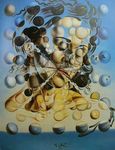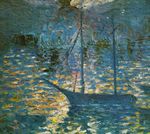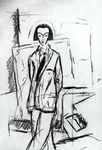ARTISTS IN THE NEWS - August 2021 IssueRevised08162021
←
→
Page content transcription
If your browser does not render page correctly, please read the page content below
ARTISTS IN THE NEWS
SALVADOR DALI
You may be wondering, Salvador Dali is in the news?
Dali, the surrealist artist, came to
my mind this month as another
example of the "unreal" looking
"real". Our Spotlight Artist,
Schatz, creates paintings
without paint or brushes and
Salvador Dali painted unreal
reality. This month also marked
the 76th anniversary of the
devastation of the atom bomb
on Hiroshima which had a
profound effect on Dali---
inspiring him to announce in a
1951 news conference that he
was the “First Painter of the
Atomic Age” and dismissed all
his works until that point as
“merely evolution.” Uranium and Atomica Melancholica Idyll - 1945 - oil on canvas- Salvador Dali
"The atomic explosion of August 6, 1945, shook me seismically,” Dalí declared. “...the
atom is my favorite food for thought. Many of the landscapes painted in this period
express the great fear inspired in me by the announcement of that explosion." In his
1945 painting, Uranium and Atomica Melancholica Idyll , the absolute destructive
power of the atomic bomb is not conveyed through the usual, iconic symbol of the
mushroom cloud, but rather through an accumulation of associative images, ranging
from a stylized fireball-like explosion to American baseball players, warplanes as facial
features, and elephants with insect-like legs, all of whom hit, drop or release deadly
egg-shaped atom bombs. From Little League to "Little Boy" (code-name for the bomb)
was not such a huge leap for Dalí’s Surrealist, elastic imagination. As Jean-Paul Sartre
argued in his 1946 essay “War and Fear,” "...living with the threat of nuclear war was the
beginning of the age of abstract mass murder. In other times, one risked one’s life
against the lives of others; one saw one’s dead enemies in close proximity--- one could
touch their wounds.” But today, atomic warfare means unleashing catastrophic
destruction from afar. Without taking a risk, Sartre concluded,“one dies for nothing.”
This form of existential angst is clearly discernible in Dalí’s melancholic painting. It
references the living nightmare of the threat of instantaneous annihilation in a post-
Hiroshima world. It is a somber work whose iconography remains indebted to Dali’s
earlier Surrealist vocabulary of melting watches, burning giraffes and paranoiac-
double images. It deftly illustrates the deadly and insular explosive force of energy
released from indifferent and inhuman matter instead of man-to-man war combat.Dali succumbed to mysticism: The painting below is a portrait of Gala
Nuclear Mysticism. The Hiroshima explosion Dali, his wife and muse. Her face is
coincided with his own classicist explosion. Art composed of densely populated spheres,
News commented: "The possibility cannot be representing atomic particles, which give
ruled out that Dali will be giving more attention a distinct 3-D effect. The title refers to a
to the conscious realm from now on than to the sea-nymph in Classical Mythology named
unconscious. If this does indeed be the case, Galatea who was known for her virtue.
nothing need prevent him from becoming the Galatea of the Spheres is one of the most
greatest academic painter of the twentieth renowned paintings from Dali’s Nuclear
century." Mysticism period.
After the Second World War, Dali did not
immediately return to Europe. The change from
the psychoanalysis Dali to the nuclear physics
Dali was making heavy demands on him. In his
Mystical Manifesto, "Many of the scenes I have
painted in this period express the immense fear
that took hold of me when I heard of the
explosion of the bomb. I used my paranoiac-
critical method to analyze the world. I want to
perceive and understand the hidden powers
and laws of things, in order to have them in my
power."
Galatea of the Spheres -1952 - Salvador Dali
I couldn't do a piece on Dali without
including his most famous (and
much-reproduced) work of art, The
Persistence of Memory (1931) even
though it was just 14 years before his
"Nuclear Mysticism" period that's
being featured in this article. I enjoy,
as I hope you do, viewing and
analyzing a great artist's works and
Leda Atomica, 1949 - Salvador Dali how they evolved.
Dali , true to his now "Nuclear Mysticism" and the
discontinuity of matter, he incorporated a sense of
levitation into his Leda Atomica. Just as atomic
particles do not physically touch, so here Dali
suspends even the water above the shore - an
element that would figure into many other later
works. Every object in the painting is carefully
painted to be motionless in space, even though
nothing in the painting is connected. Leda looks as
if she is trying to touch the back of the swan's head,
but doesn't do it. Many famous painters have
The Persistence of Memory (1931)
interpreted Greek mythology's "Leda and the
Swan".But, What About the Man?
He believed that life is the greatest form of art, so he lived his life boldly, with extreme
eccentricity, long hair, dandy clothes and a stylish mustache. Read on to find out more
about this unpredictable character and take a long look at a few images that you'll be
surprised to see --- since most people are only familiar with his surrealism.
He was Expelled from Art School
Even though Dali studied for many years at the Special Painting, Sculpture and
Engraving School of San Fernando in Madrid, he never graduated. That’s because,
during his last exam at the school, he insulted a professor. He believed that the teachers
weren’t qualified enough to test him. He was immediately expelled. But some good did
come out of his college days---while there he met Le Corbusier, Einstein, Calder and
Stravinsky,
Landscape near Figueres - Boat - (1918) Age 14 Still Life- (1918) Age 14
(1910) (Age 6)
Dali was influenced by Freud
Psychoanalyst Sigmund Freud and his theories were what inspired
Dali to capture images of dreams and hallucinations. Dali never
used drugs and only drank alcohol in moderation. Quote: "I don't
do drugs, I am drugs." He accessed his subconscious through the
state between being awake and sleep.
He believed he was reincarnated
Dali’s parents had a son (also called Salvador) who died extremely
young. So, when Dali was born 9 months to the day after the death
of the first Dali child, the family believed that he was a
reincarnation of his older brother.
Dali worked with Disney
After making surreal films in Paris with director Luis Buñuel, Dalí
Self-Portrait- (1922) Age 18
went to Hollywood. His paintings were used in a dream sequence in the 1945 Alfred
Hitchcock film ‘Spellbound’ . A year later, he created a 10-minute film with Walt Disney
called "Destino" - a beautiful trippy film that was not released until 2003.
He was shunned by surrealists
By 1930, Salvador Dalí had become a notorious figure of the Surrealist movement but he
clashed with other members and was expelled from the group in 1934. Whether it was
caused by his feud with Surrealist leader André Breton or due to his "counter-
revolutionary activity” during WWII, we’ll never know. Even after leaving the Surrealist
movement, Dalí continued to exhibit his work in international Surrealist shows.
The melting clock keeps on ticking!You can also read

























































